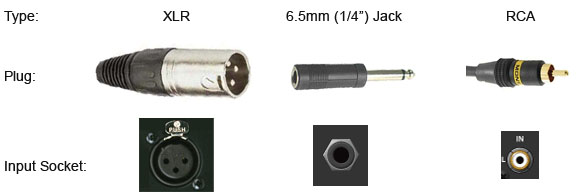Microphone types
When recording either live or in a studio, it is very important to be aware of the characteristics that different microphones possess in order to create the best sounding final product.
Although there have been many different microphone types developed for recording purpose, two types stand out as being much more popular choices.
Dynamic Microphones – Overall a dynamic microphone is a sturdier and more reliable microphone option for those who play live, record their vocals or guitars at high levels and swing their microphones around due to the fact if you drop them they’ll be ok. They take an awful lot of noise before they start to distort, so for heavier guitars and more aggressive vocals in a live setting, this microphone is for you. The technical bit is that these microphones use a moving coil magnetic diaphragm to produce the audio signal and can handle high Sound Pressure Levels (SPL).
Dynamic microphones work much better on low-medium frequency instruments such as drums and electric guitar cabs.
Condenser microphones- Condenser microphones are extremely sensitive and due to the fact they use a conductive diaphragm which vibrates with sound pressure and uses capacitance to create the audio signal, they are very susceptible to distorting at higher levels, so not ideal for recording guitar amps up close. You will often see a condenser microphone with a popper stopper or “pop shield” filter placed in front of it when someone is recording vocals with them. This is to stop excess air pressure vibrating the microphone. Due to the fact they are so sensitive, you get a far more natural and transparent recording with a condenser microphone.
Condenser microphones work much better on high frequency instruments such as cymbals, a piano or an acoustic guitar.
Common brands of the dynamic and condenser used in the music industry are as follows:
Dynamic – Shure SM57, Shure SM58, Shure SM7B, Electrovoice RE20, Sennheiser MD421 11
Condenser – Audio Technica AT2035, Studio projects B1, Rode NT1-A, Blue Microphones Bluebird, Se Electronics 2200a 11.
Frequency Response
Frequency response defines the range of sound that a microphone can reproduce and how its output varies within that range. The frequency response is the most significant factor in determining the sound signature of a microphone. The frequency response of a mic is represented graphically by a response curve. The two most common types are flat response and shaped, or tailored, response.
A flat response microphone is equally sensitive to all frequency ranges, so its response curve is in fact nearly a flat line. A flat response microphone reproduces the sound source accurately with little or no variation from the original sound. That’s good if you’re recording musical instruments or sound effects, but a mic with a flat response usually doesn’t sound good on voices.
A shaped response microphone is more sensitive to some frequency ranges than others. Its response curve has peaks and valleys. Many microphones that have a shaped response are less sensitive to low frequencies, which reduces the pickup of both handling noise and the rumble from the stage when the mic is mounted on a stand. A shaped response microphone also typically has a boost in the upper mid-range, usually between 3,000 and 6,000 Hz. This is called apresence rise, and it enhances the clarity, or “punch,” of voices and instruments.
Ideally, whether a microphone has a flat or shaped frequency response, a frequency response curve should be a fairly smooth line. If it has a lot of abrupt peaks and valleys, the microphone probably won’t sound very natural, and it may have a greater tendency to cause feedback with a PA system.
Setting up the microphones on a drumkit
I found that this tutorial was very useful in showing the best positions of the microphones as well as explaining what each microphone does and outlining the difficulties and obstacles you might face when recording a drumkit.
Although this may be considered quite basic approach to a Drum Kit microphone set up as the cymbals are not individually miced up, in our project we also chose not to individually mic up the cymbals but instead relied on the overheads to give us the overall sound of the cymbals. This being said if in the future I was professionally setting the microphones on the drumkit I would look to individually mic up the high hat as well as maybe the ride cymbal and the crash/crashes. This would probably give me an overall better sound.
For a microphone set up for a drumkit you would use a mixture of dynamic microphones and condenser microphones. For each Drum you would use a dynamic as they are low frequencies, whereas with the overheads you would use condenser microphones as they would capture the overall sound much better than the dynamic which is better for capturing direct sound.
More microphone placement ideas
Mixing Desks
Mixing Desks are split into two models, Digital and Analogue. In this project I will be researching the Digital mixing desk as It is what we will be using in this project and it is constantly growing in use throughout the industry. This is not to say that the digital desk does a better job than the analogue as the analogue has a brilliant reputation for recording in the music industry, regardless of this both desks have very similar characteristics and features.
Inputs – 
Input levels –
The level of an audio signal refers to the voltage level of the signal. Signals can be divided into three categories: Mic-level (low), line-level (a bit higher) and loudspeaker-level (very high). Microphones produce a mic-level signal, whereas most audio devices such as disc players produce a line-level signal. Loudspeaker-level signals are produced by amplifiers and are only appropriate for plugging into a speaker — never plug a loudspeaker-level signal into anything else.
Sound mixers must be able to accommodate both mic-level and line-level signals. In some cases there are two separate inputs for each channel and you select the appropriate one. It is also common to include some sort of switch to select between inputs and/or signal levels.
Famous Music Producers and the techniques they use
Andre Romelle Young (born February 18, 1965), better known by his stage name Dr. Dre, is an American rapper, record producer, and entrepreneur. He is the founder and current CEO of Aftermath Entertainment and Beats Electronics. Dre was previously the co-owner of, and an artist on, Death Row Records. He has produced albums for and overseen the careers of many rappers, including 2pac, The D.O.C., Snoop Dogg, Eminem, Xzibit, Knoc-turn’al, 50 cent, The Game, and Kendrick Lamar. He is credited as a key figure in the popularization of West coast G-funk, a style of rap music characterized as synthesizer-based with slow, heavy beats. As of 2017, he is the third richest figure in hiphop according to Forbes with a net worth of $740 million.
Below is an interesting article which creates a good insight into Dr Dre’s work as a producer.
By looking at Dr Dre it has helped me understand the idea that in mixing music and producing it, less is more. For example Dr Dre is often praised for his clean, fresh sound which seems like it would be very difficult to produce, however when mixing music it is very easy to overcompensate and tweak songs too much when looking for a perfect sound, whereas simply adding a tiny bit of EQ would have made it sound incredible.
